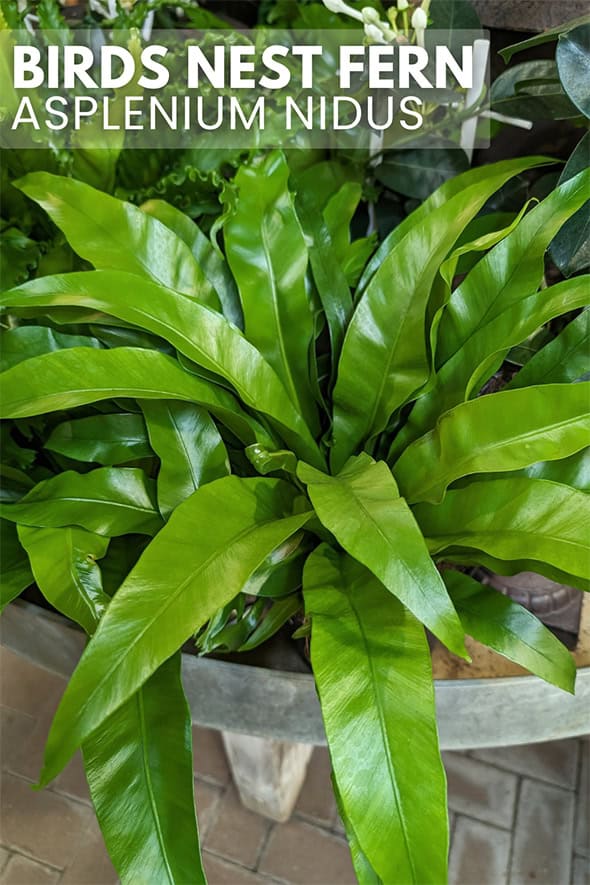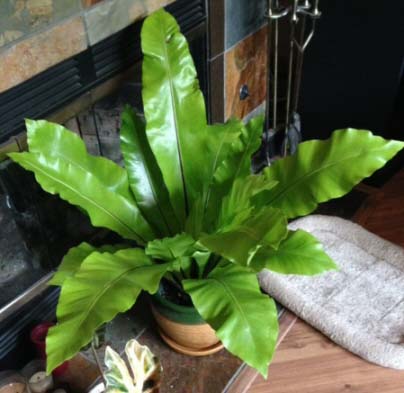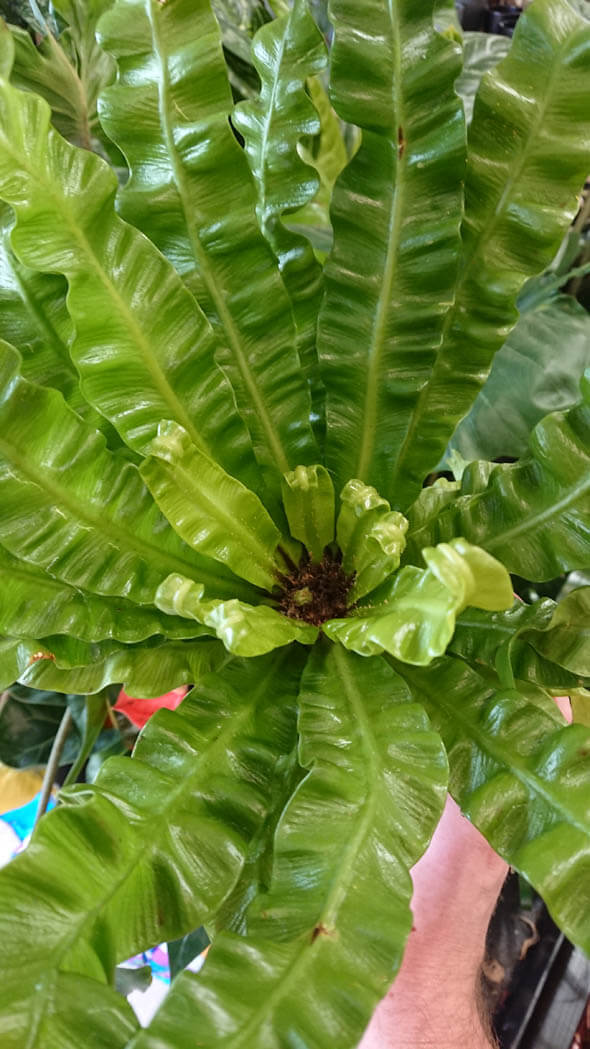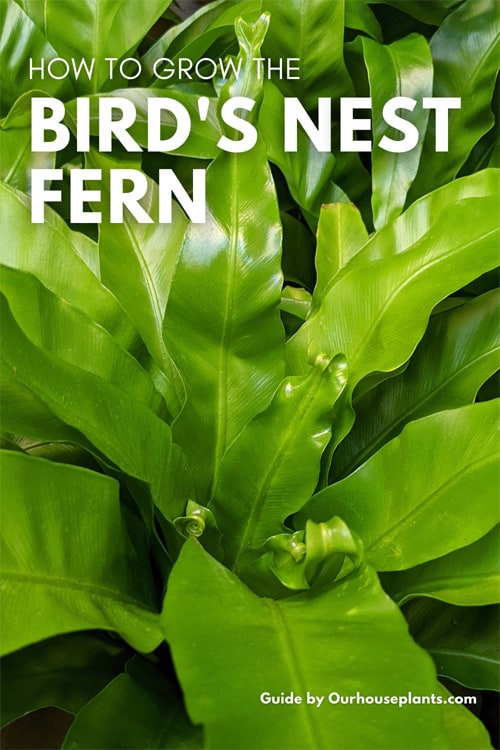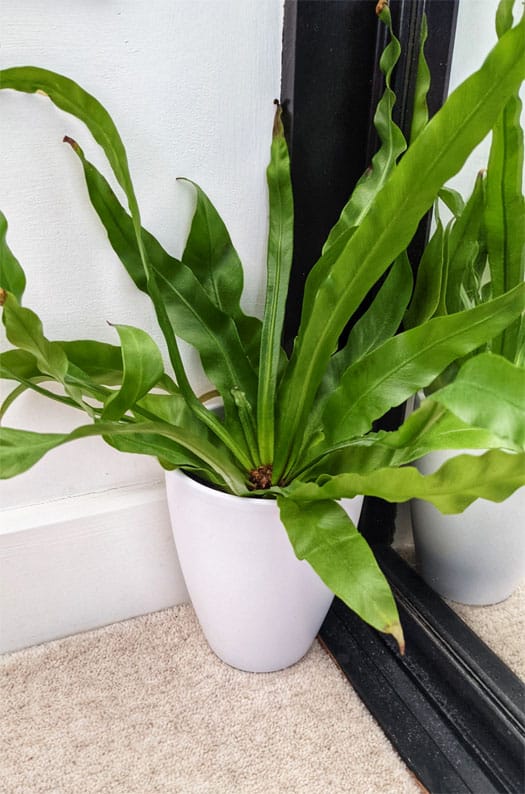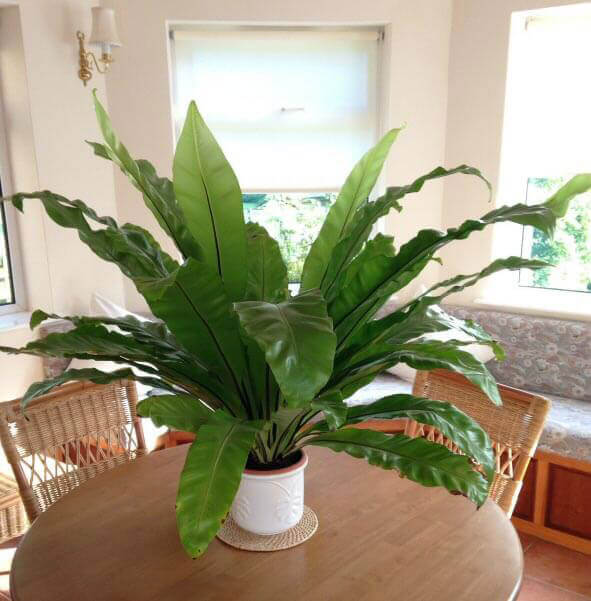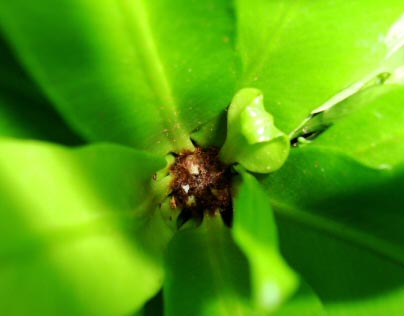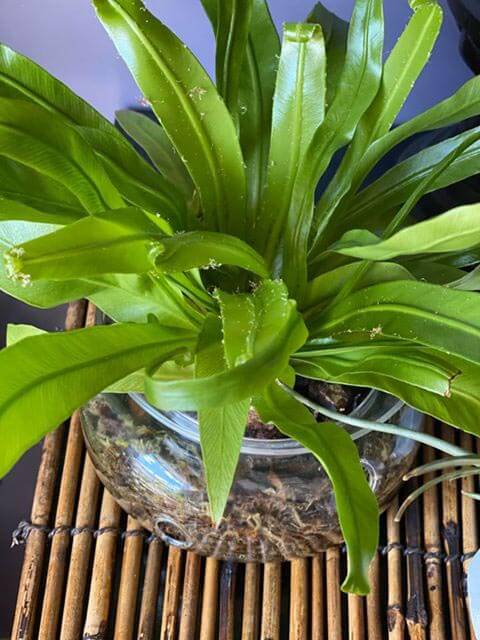The Bird's Nest Fern or Asplenium nidus is one of the several popular and beautiful ferns grown as houseplants. Ferns like this one can be grown in North facing windows perfectly well and will truly relish the type of light and cooler temperatures these places receive.
In return the Bird's Nest Fern will give you lots of naturally glossy leaves arranged in a circular pattern which resemble a bird's nest (hence the common name for these houseplants).
The Birds Nest Fern is a tropical plant that grows naturally as an epiphytic fern in partial shade. Although, it's very versatile as a houseplant and can grow in various light conditions and in a normal potting mix.
These Ferns have very few problems, are cheap to purchase and readily available. They're usually fairly small but over time and with decent care they will expand outwards in a circle shape. Each new frond (leaf) should be a little longer and broader than the last.
The fronds will emerge from the very center of the plant, this is the growth point and it's important not to damage this. If you damage it or it rots from overwatering, that's generally it for your plant because new growth won't replace the older fronds.
They can be grown in most locations in the average home, however people will often grow them down low for visual appeal. At eye level it's a little boring to look at, but when viewed from above and looked down upon you can better appreciate the way it grows.
Bird Nest Ferns can look good in many areas of your home. - Photo by Zell.
When it comes to what Bird Nest Ferns you can buy there is generally really only one common type and that is Asplenium nidus. On occasion a plant may be sold as Asplenium australasicum, either intentionally or accidentally. Both plants look very similar, but Asplenium australasicum tends to be the better outdoor plant.
As with most ferns it's difficult for growers and breeders to create different cultivars. Although you may still be able to find some which have curly or frilly ruffled leaves if you search hard enough.
The photo below shows a newer cultivar called "Crispy Wave" because of how the entire leaf from base to tip is crinkled.
Although harder to find, there are cultivars out there that have crinkled rather than flat and smooth leaves.
Even if you can't find different varieties in your local houseplant stores, a lot of people would say the original is the most beautiful looking anyway. So now you know a bit about the plant let's get cracking with the Birds Nest Fern care instructions.

Hi, I'm Tom!
If you're like me and enjoy the challenge of growing houseplants and getting them to thrive, then Ourhouseplants can help. This website shares my knowledge and years of growing plants and provides (hopefully) helpful advice on properly caring for your indoor plant friends.
Only medium light levels are needed for the Bird's Nest Fern to do well and if this can be at a consistent level over the day that's even better. This is in part why they make ideal investments for your tricky North facing windows (if you live in the Northern Hemisphere), this type of consistent light is loved by artists and by this houseplant.
If you don't have such a spot or your rooms don't face North just be sure to keep it out of harsh prolonged direct sunlight and it should be fine. They'll cope with low light for a while, I was able to keep one of mine in this position for several years. However they'll barely grow and tend to decline over time.
Ferns, like many houseplants, often fail in homes because of how they are treated when watered - either they get too much or not enough water.
The odd mistake won't hurt, but you need to try and work with your Fern by keeping the soil just moist throughout the entire growing seasons (Spring, Summer and Autumn / Fall).
Can you water the Crown?
The growth point or "crown" is water resistant and so water can fall on it without issue. However overwatering or too much water in this area in general can cause rotting so be careful.
This means you ideally shouldn't be allowing the soil to dry out at all, but equally you mustn't water so much and often that the soil is classed as soggy or wet.
In Winter you only need to water every few weeks at most, because the need for water drastically reduces at this time of year and a lot of unused water sitting around the roots will encourage root rot.
The plant loves high humidity to really thrive, which is another reason why they adore humid terrariums, sunrooms and conservatories.
TIP - The key to growing a very large Bird Nest Fern is to focus on humidity.
You can of course still grow a more modest sized plant without specialist equipment, my humidity guide should give you some easy ideas and pointers.
They're particularly good indoor plants for bathrooms or a frequently used kitchen because these places tend to have a steamy atmosphere.
This is important because a Bird Nest Fern plant needs some humidity to do really well indoors. They'll still cope and deal with an average room humidity but for that extra shine and extra large size you'll need to bump the humidity level if it's usually low in your growing environment (less than 60%).
Alternatively, the Bird Nest Fern is an ideal plant to keep in a home terrarium or glass bottle garden, these enclosed spaces create naturally moist and protective environments that many types of plants, including ferns, will do well in.
The older glass bottle garden are a little old fashioned, but as design pieces themselves they have started to become more popular again with interior designers. You may have a larger selection to pick from at car boot sales or in antique shops, but Amazon have a few of the more modern fashion trends to give you some inspiration. Take a look at the links below.
The Bird's Nest Fern is not fussy when it comes fertilizing (providing you don't over do it). But over a long period the leaves will dull and growth will come to a halt if you never provide any feed at all. It's best therefore to either feed weakly once a month or so when it's in active growth, or at normal strength once every three months.
Cool to average warmth is what you want to provide here. This is one houseplant which can struggle in really warm rooms, so it might not be the best choice for a hot living room, snug or next to a radiator or used fireplace.
A temperature within the following range is needed for it to do well, 10°C (50°F) - 22°C (72°F).
Bird's Nest Ferns will grow well in cooler spots in your home.
It's time to repot when the thin roots completely fill the existing pot, once this has happened it's time to move it on into a slightly larger container. If you don't, growth will stall before eventually stopping completely.
As a rule of thumb a young Bird Nest Fern plant will need to be repotted once every year until it reaches a good size, after which you will only need to repot perhaps once every couple of years.
Bear in mind that even large plants can still do well in smaller pots (see photo below) so there is no need to repot into a significantly bigger planter each time. Just be prepared to water more often as a smaller container will store less moisture.
These plants do really well in small pots, so repotting isn't essential if you want a bigger plant.
When you're getting your hands dirty with repotting your fern, you don't need to use a specific soil type or do anything particularly fancy. Standard potting soil or one with a small amount of added drainage is fine and if the roots are very compacted you might want to gently loosen them a little with your fingers.
When you're packing the new potting mix and plant into the new pot, it's important that the crown is not buried, this could prevent growth but also risks water pooling and rotting the crown. So it must sit at the same level it sat at in the previous pot.
Ferns, including the Asplenium Nidus, will form spores in time which can be used to propagate new plants. Although I'll give most things a try, propagating ferns using this method is not one of them. It's really difficult and you do need special equipment to pull it off successfully.
So instead, I spend a little money (because they're generally cheap plants anyway) and buy new ones whenever I want an extra one.
Growth will be slow if the roots have no space to grow into or when the temperature is very cold.
However, providing you're caring for your Bird's Nest Fern correctly, growth will be quite rapid and regular during the growing seasons, new leaves will constantly emerge from the central "nest".
A word of caution however - you must not handle the delicate young fronds as they're emerging because of how fragile they are. New fronds have a high chance of becoming damaged and deformed if you touch them, so try not to.
Delicate fronds emerge from a small healthy plant. It will take many years to reach a mature size, but this is still a great start.
A max height of 120cm / 4ft and a spread of 90cm / 3ft can be attained after many years, but only in a very humid environment. Half these size estimates in a normal room.
Does the Bird's Nest Fern have flowers? The answer to this is no it doesn't. Instead this houseplant is all about the lush tropical and tranquil looking foliage.
No, this fern isn't toxic to people, cats or dogs.
Ferns in general are quite sensitive to chemicals so you should avoid leaf shine products to prevent issues. The leaves are naturally glossy anyway, but of course if they start to dull from dust you can just pop the plant under a warm shower for a minute to wash the grime away.
Average Light The perfect plant for those spots in your home that receive less light. No direct sunlight, but don't hide it in a gloomy corner either.
Average Watering It's forgiving if you let the soil dry out occasionally, but for a thriving plant keep the soil "just moist" all year round.
Cool to Average Temperature Provide temperatures between 10°C (50°F) - 22°C (72°F).
Feeding Feed weakly once a month or at normal strength once every two or three months.
Why are there are small dark brown spots on the fronds / leaves?
In most cases these spots are actually spores, which are basically seeds. It's perfectly normal and indicates you have a mature and healthy plant, just leave them as they are.
Make sure however the brown spots aren't Scale Insects which can look awfully similar. Spores will be regularly spaced and only appear on older Bird Nest Ferns, whereas Scale will have a random pattern and can afflict a plant at any age.
If you do have a Scale Insect problem get rid of them quickly to prevent them from spreading to other houseplants. The link above will help you get to grips with doing this.
Brown Fuzz on the Fronds.
This is quite a common issue and you will usually see it in Spring and early Summer. The fronds are covered in a fine brown hairy type of fuzz. Fortunately it's not a problem, has a simple explanation and fix.
Birds Nest Fern with brown Fuzz on the fronds.
If you look down into the heart of your plant you will often see a brown mound that looks a bit like a truffle chocolate. New Fronds or "fiddleheads" emerge from this central part of the plant and grow out of the mound. When this happens and the frond pushes through, it brings with it some brown fuzz which sticks to the frond.
It's totally harmless. You can leave it alone and it will eventually dry out and become like dust. Although, if you really don't like it, you can gently wash it off. Either way not a big issue or something to be concerned about.
Why are there brown tips on the leaves on my Bird's Nest Fern?
In most cases this is a result of dry air, or allowing the soil to dry out too much before re watering. On occasion it can also be an indication you're overwatering. Remember that the soil should be moist for much of the time, not really dry or really wet.
Why are the leaves on my Bird's Nest Fern turning yellow?
If the yellowing starts at the ends of the fronds this is probably normal aging. If the yellow is starting from the base of the fronds then the temperature is likely on the high side, find a cooler place in your home for it to live. Other causes could be from using hard cold water, exposure to draughts, or chemicals.
Common Pests
Generally, these are reasonably pest resistant plants. However I have seen Thrips and Aphids on mine over the years, it seems to repel everything else.
Credit for the Asplenium nidus photo in the green - Gallery - KENPEI
Credit for the Bird Nest Fern by a fireplace - Article / Gallery - Zell
